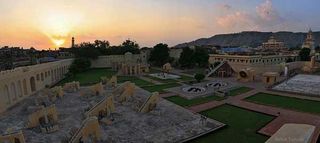Saving Humanity's Star-Gazing History

Twohistorichubs of scientific inquiry, the 18th-century Jantar Mantar Observatoryin Indiaand the 13th-century DengFeng Observatory in China, have been added tothe listof UNESCO's World Heritage Sites.
Theannouncement of the additions came last week, during the U.N. body'sannualmeeting. Several natural sites also became newly named WorldHeritage Sites,and some were addedor removed from another list that notes sites that are potentiallyendangered.
TheJantar Mantarcomplexin Jaipur, begun inthe 1720s by a powerful Indian prince, resembles a giant's spilled boxof TinkerToys. The buildings themselves are astronomical instruments, andseveral ofthem are among the largest of their kind in the world. Two enormousbowl-shapedsundials ? items that would look at home in a modern-day skate park ?weredesigned so astronomers could climb inside to take measurements. Theobservatory's 19 buildings were completed in 1738.
NearDengFengCity in China's Henan province, the DengFeng Observatory complexincludes 13different monuments. The Yuan Dynasty observatory, built in 1279 nearanancient capital on Mount Songshang, is the most remarkable astronomicalfeatureof the sprawling site. The brick tower, more than 30 feet (9.5 meters) tall andwith sweeping stone staircases that wing out on both sides, was used totrack the sun'snoonday shadow over the course of theyear, a key tool for calendar-making.
Theselectionof these sites by the UNESCO World Heritage Committee coincided withthepublication of a joint study conducted by the InternationalAstronomical Union andthe International Council on Monuments and Sites, an advising body tothe UnitedNations.
Theirreportoutlines the wide variety of objects and sites around the worldshowcasinghuman astronomical endeavors ? a wild mix indeed. A 12,000-year-old cowbone scratchedwith a lunar calendar, the pyramidsof Giza in Egypt,14th-century timepieces in a cathedral in France, and anoperational 1950s-eraobservatory atop a mountain in Chile are just a few of the itemsprofiled inthe report.
Perhapsmoreimportant, the paper lays out a methodology for assessing and assigningvalueto such places and objects, said Thomas Hockey, secretary to the groupthatauthored the report, and a professor of astronomy at the University ofNorthernIowa.
Get the Space.com Newsletter
Breaking space news, the latest updates on rocket launches, skywatching events and more!
AlthoughtheIndian and Chinese observatories are included in the report, Hockeyemphasizedthat the study doesn't represent a hit list of recommendations forWorldHeritage status.
"It'snot our place to nominate," Hockey said. "That is done by countries."
OklahomaState University professor Subhash Kak, who wrote the report's chapteron India,said the addition of Jantar Mantar to the World Heritage List not onlywill giveleverage to local officials seeking increased federal funds to preservethesite, it will raise Jantar Mantar's profile for tourists, a key sourceofrevenue.
"It'sextremelyimportant," Kak said. And not only for cash flow, but to make surehumansmaintain an awareness of what's happening above their heads.
"Avastmajority are totally disconnected from the drama of the cosmos," Kaksaid."Once you see structures like this, it could provide the epiphany whichwould make people want to find out more about how you map the motion ofthestars, the sun, the moon."
- Gallery:AncientObservatories
- The7 Most Mysterious Archeological Finds on Earth
- Top10 AncientCapitals
Thisarticle was provided by OurAmazingPlanet,a sister site to SPACE.com.
Join our Space Forums to keep talking space on the latest missions, night sky and more! And if you have a news tip, correction or comment, let us know at: community@space.com.
